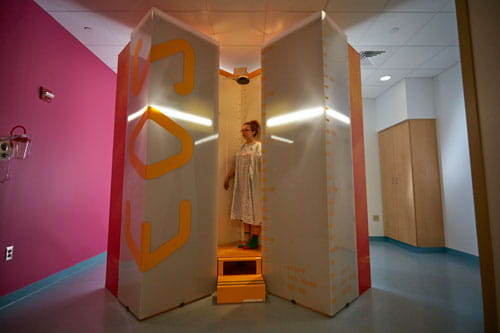 Children with scoliosis and kyphosis have access to one of the world's most advanced imaging systems at the Spine Center.
Children with scoliosis and kyphosis have access to one of the world's most advanced imaging systems at the Spine Center.
The EOS™ imaging system is a state-of-the art machine that:
- Takes full-body, 3D images much like x-rays, but with only a fraction of the radiation that most x-ray machines use.
- Creates very detailed, high quality images of the spine and joints. This gives your doctor precise measurements without the need for taking more than one image.
- Produces images in seconds, while exposing your child to only small amounts of radiation.
The EOS system's unique design allows us to take pictures of your child or teen, while either standing or sitting. Images of your child while standing show the spine and other joints as they naturally bear the body's weight.
Why Low-Dose Radiation is Important
We all have daily exposure to small amounts of radiation, called “background radiation.” It comes from our sun and stars, but also from the Earth itself.
X-rays, CT scans, and other medical imaging tests that use nuclear medicine all expose you to radiation.
No single test is of concern in your overall exposure to radiation, but each exposure adds up over your lifetime. Some people who have had a large number of radiation exposures may be at increased risk of getting cancer.
Children with scoliosis or kyphosis often need scans of their spine and joints on a regular basis over many years.
The EOS imaging system uses FDA-approved micro dose radiation. This means we can ensure that your child receives the lowest dose of radiation as possible to monitor his or her condition.
Comparison of radiation exposure by test
Test Type – Amount of Radiation
- EOS – About one day's worth of background radiation.
- X-ray – About one week's worth of normal background radiation exposure.
- CT scan of the belly – About 20 months' worth of background radiation.









 Children with
Children with